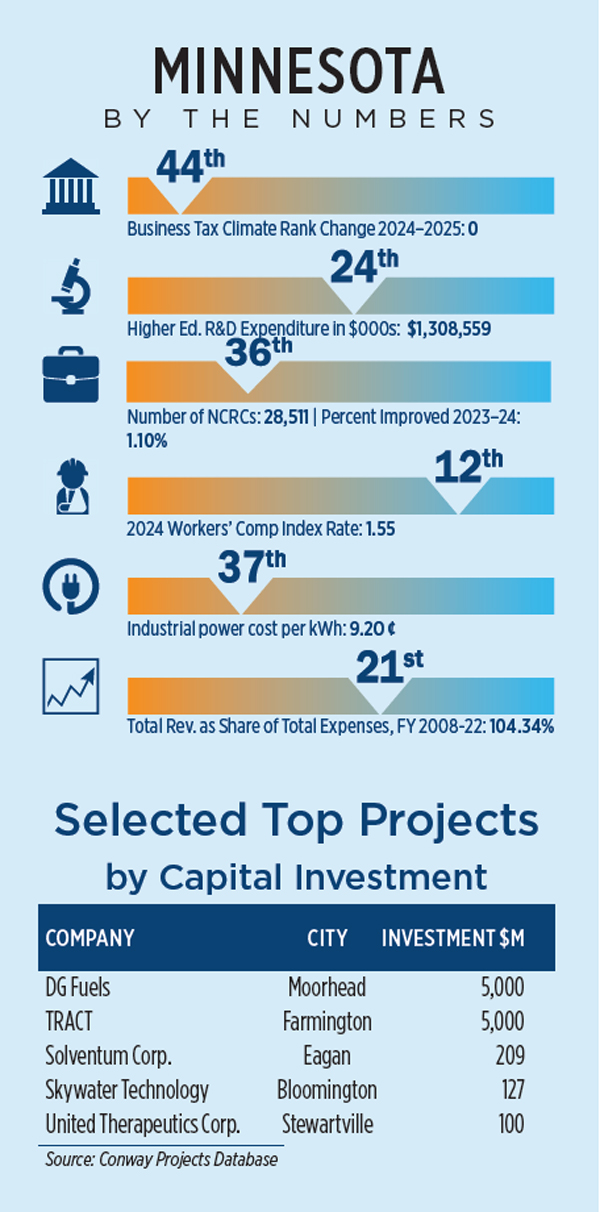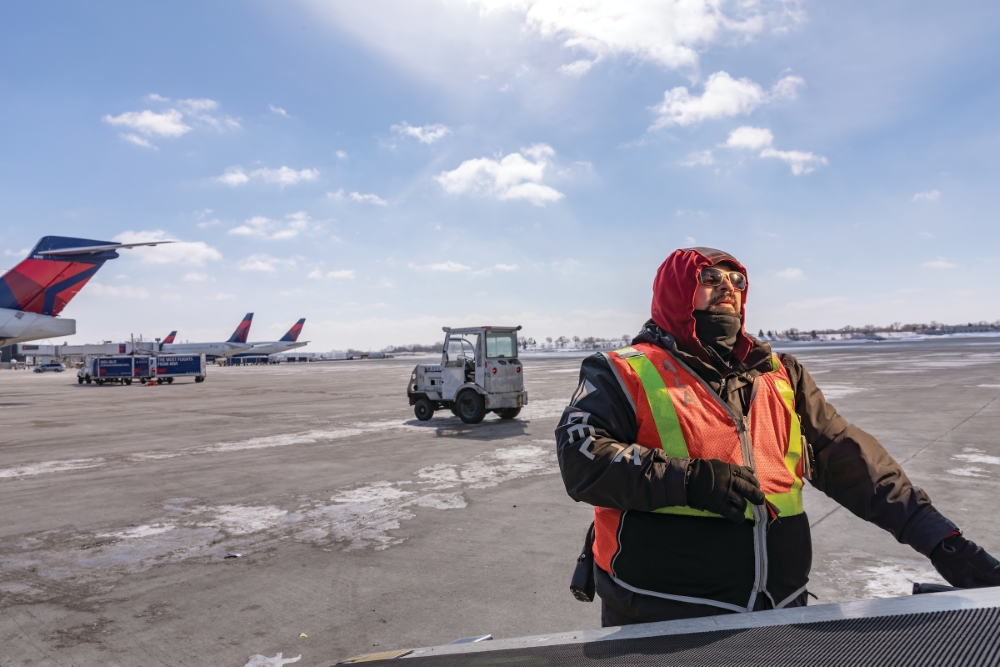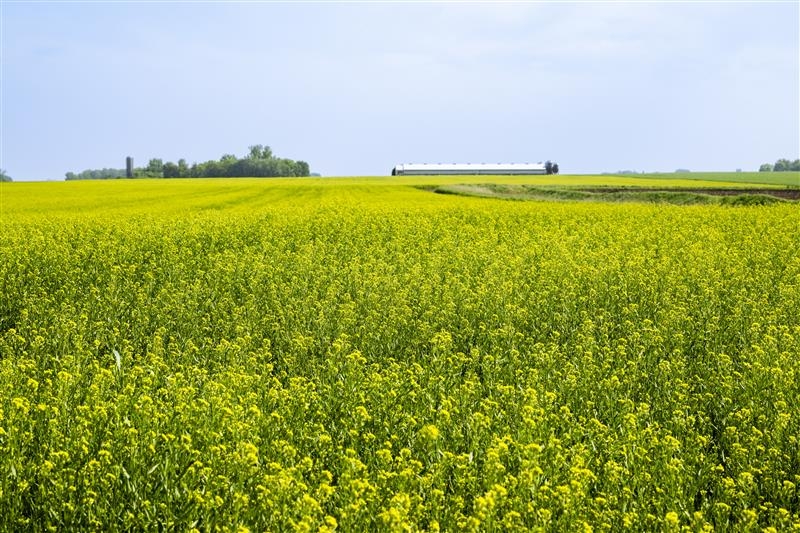As America races toward a greener future, the demand for sustainable aviation fuel (SAF) has never been higher. Minnesota is seizing the opportunity to break into this emerging industry before the competition, leveraging its agricultural strength to kickstart a hub that could establish the state as a pioneer in SAF production.
The Minnesota SAF Hub, a coalition comprising the Greater MSP Partnership, Bank of America, Delta Air Lines, Ecolab, Xcel Energy and other stakeholders, is on a journey to develop a fully integrated SAF supply chain in Minnesota.
In partnership with Delta, Flint Hills Resources is in the early stages of developing a facility capable of blending up to 30 million gallons of neat (unblended) SAF with conventional jet fuel. This project will be a first-of-its-kind facility between the coasts. Located at Flint Hills’ Pine Bend refinery in Rosemount, the facility will deliver the blended fuel via its existing pipeline to Minneapolis-St. Paul International Airport (MSP), Delta’s second-largest hub. Shell has already committed to supplying the neat SAF for the project.
A “Demand Consortium” including Bank of America, Deloitte, Delta and Ecolab will purchase the first several million gallons of SAF each year, starting during the second half of 2025. Each participating company is providing funding to scale production, drive down costs, increase continued demand and reduce carbon emissions associated with their employee business travel.
“While Delta has committed to purchasing millions of gallons of SAF, there isn’t enough being produced today to fuel the world’s commercial airlines for a single week,” said Peter Carter, Delta’s executive vice president of external affairs, in September. “That’s why this blending facility is so important — it’s like hanging an ‘Open for Business’ sign to SAF producers to consider doing business in Minnesota, where we see SAF as a great opportunity for all players across the value chain.”

Plant-Powered Progress
Minnesota SAF Hub partners at the University of Minnesota Forever Green Initiative are also developing a novel crop called winter camelina seed, which can be used for various purposes, including producing oil for conversion into SAF. It has one of the lowest carbon intensity scores among the many feedstocks used for producing SAF today. Corn, soybeans, canola, continuous living cover crops, agricultural biomass, woody biomass, hydrogen, waste oils and fats are also used to produce SAF, all of which are available in Minnesota.
Cargill, an American multinational food corporation based in Minnetonka, is collaborating with the university on this project, expanding its active role in growing the Midwest’s supply of this versatile crop.
In 2023, Cargill worked with Minnesotan and North Dakotan farmers to plant 2,000 acres of winter camelina. In September 2024, the first 7,000-gallon shipment of blended SAF made from these crops arrived at the Minneapolis-St. Paul International Airport fueling facility.
“This initial SAF delivery is another example of how we are making SAF real in Minnesota and showing the world how to do it right,” said Peter Frosch, president and CEO of the GREATER MSP Partnership. “We are highlighting the first SAF flight from MSP International as another major milestone in our push to build a SAF economy anchored in Minnesota. This ambitious effort is moving fast and gaining momentum due to the bold leadership of Minnesota SAF Hub partner organizations. The Minnesota SAF Hub is on track to create thousands of good jobs for Minnesotans by delivering a climate solution the nation and world urgently need.”
In January, through its Bioenergy Technologies Office (BETO), the U.S. Department of Energy (DOE) awarded the University of Minnesota $10 million for the Oilseed Crops to Sustain the Environment and Meet Energy Demand (OILSEED) project led by Mitchell Hunter, PhD, co-director of the university’s Forever Green Initiative. The Minnesota Department of Agriculture, U of M, Cargill and North Dakota State University are providing a combined $2.5 million in additional funds.
“Winter oilseed crops like camelina and pennycress have the potential to be adopted on millions of acres in our region in the coming years and decades,” Hunter said, citing a recent report that found widespread adoption of camelina, pennycress and other crops that provide over-winter cover could reduce nitrogen loss from farmland by 23% and soil erosion by 35%. “The winter oilseeds can preserve topsoil, protect water quality, feed pollinators and, by producing low-carbon fuel, help fight climate change, all while giving farmers a new source of income.”
Sustainable Growth
While building a strong network from within is essential, the true test of a hub’s potential comes when a newcomer decides to join the club. Through initiatives such as the SAF Tax Credit, the coalition is actively working to bring producers of all sizes and varying feedstocks to the state. DG Fuels’ decision to locate a manufacturing facility in Moorhead, expected to generate $50 billion in economic impact, marked a major milestone for the Minnesota SAF Hub, cementing the state’s reputation as a rising leader in the industry.

A Delta aircraft load agent at Minneapolis-St. Paul International Airport (MSP)
Image courtesy of Delta Airlines
Attracting a project of this magnitude will make significant headway in addressing the demand for SAF at MSP International Airport, which currently outstrips supply. DG Fuels expects this new facility to produce 193 million gallons of low CO2 lifecycle emission SAF each year, representing nearly half of the fuel used at the airport.
As of November, the Minnesota SAF Hub was working with DG Fuels and the City of Moorhead on the next set of requirements to advance this project, including aggregating feedstocks. DG Fuels’ manufacturing process uses cellulosic biomass in the form of lower-value agricultural by-products such as corn stover and timber waste as its feedstock. It also incorporates various forms of clean hydrogen feedstock to produce near-zero carbon fuel.
Accessible labor and logistics helped the company choose Moorhead, DF Fuels Chairman and CEO Michael Darcy told Site Selection’s Ron Starner in January. “We can rail aviation fuel to refineries in Minnesota to feed our customers at the airport. That is a barrier in the rest of the country. Minnesota helped us with the logistics.” The state also helped with attitude: “Having a proactive state is always a good thing for a project,” Darcy said. “Minnesota on its own worked out a deal to have SAF refined there. We wish more states did that.”
Located within the Red River Valley, Moorhead and its neighboring communities in Clay County are surrounded by some of the nation’s most fertile land, bolstering a thriving agricultural sector that provides a strong foundation for SAF production. In addition to this wealth of natural resources, Moorhead boasts Minnesota’s largest shovel-ready industrial park, the MCCARA Industrial Park, adding to the area’s attractiveness and growing business climate.
DG Fuels estimates that its investment in Clay County will result in 650 new jobs, millions of dollars per year of on-farm income and billions of dollars in statewide economic impact.

